
Background information
In Zen mode: how a tea ceremony emptied our heads
by Darina Schweizer

In the midst of Hamburg's big city noise, the unexpected awaits: the largest Japanese garden in Europe. Expert and "lady of the camellias" Sabine Rusch shows how stones, water and plants speak their own language - and why less is more.
Happy, cheerful, exuberant: Our team trip to Hamburg was many things - except quiet. Especially for those of us who got to enjoy (or was it rather annoyed?) the beat move:
In the hustle and bustle of the city of 1.8 million people, as a plant editor I longed for a relaxed idyll. I didn't have to look far for it. Hamburg, one of the world's greenest megacities, is home to the largest Japanese garden in Europe, consisting of three parts.
I visit the most recent part in the Japanese Landscape Garden Planten un Blomen. With the expert when it comes to Japanese gardens: Sabine Rusch. The 77-year-old horticultural engineer has been giving guided tours for over twenty years. When she was still working for the Botanical Garden, she met the landscape architect Yoshikuni Araki from Hamburg's twin city Osaka. He designed and built the three Japanese Gardens in 1978, 1988 and 1991.
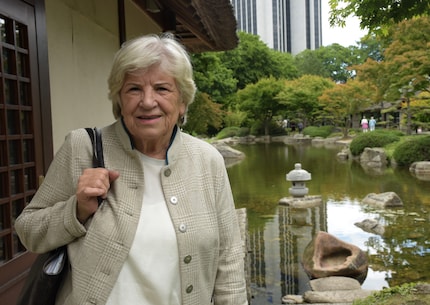
«You're sure to enjoy it», says Sabine Rusch as we greet each other and immediately invites me to come along. We meander through colourful flowered paths and past greenhouses. Behind us, the babble of voices and the hum of engines fade away - and finally, as we stand in front of the Japanese Garden, the colours.
I'm irritated - and Sabine Rusch can see it in my face. «You were expecting more colours», she says and I nod. «The plants in the Japanese garden are deliberately colour-coordinated: In summer, the green tones predominate, in autumn maple and ginkgo yellow and after winter cherry blossoms, magnolias and azaleas in pink and white. This creates a harmonious, uniform picture.» Now I can see that everything fits together. But it's not just down to the colours.
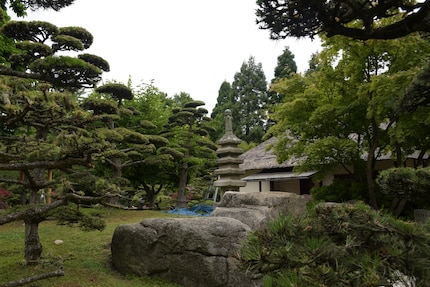
It is the overall picture of stones, water and plants: a miniature image of the world. It is not flawless, but it is much more organised than the chaotic reality behind it: the television tower, apartment blocks, skyscrapers that criss-cross between the trees. The fact that the background is part of the garden is what is known in Japanese «Shakkei», borrowed landscape, says Sabine Rusch. «It is intended to visually enlarge the garden and widen the view.»
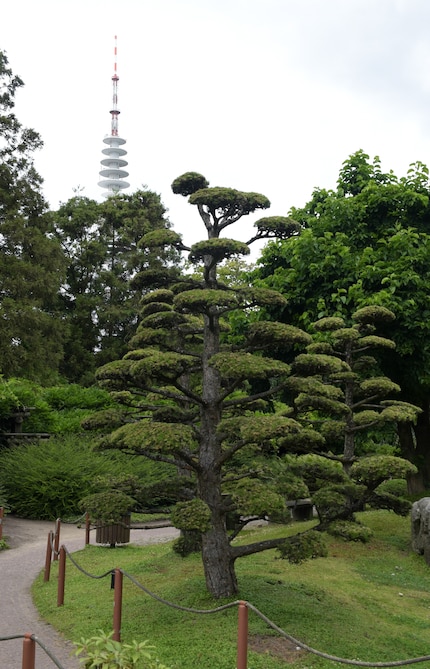
Suddenly a head sticks out of the greenery above us. A gardener is pruning a black pine. Like the stones and bushes, this should also look round and harmonious. Sabine Rusch is beaming all over her face. «So much love and perseverance has gone into this. Just imagine: All these pine trees have to be pruned several times a year. A single tree needs up to two hours of care.» The effort could be worth it, because the black pine symbolises a long life.
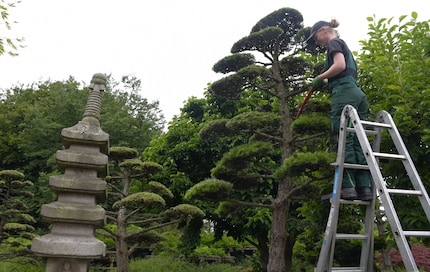
Many guests of the Japanese garden also want to live a long and healthy life. At the entrance to the tea garden is a scoop pool. Here they can wash away stress and cleanse their souls before attending a tea ceremony in the tea house behind it. I have also enjoyed this in Switzerland.
As I look up at a tree that is literally bending down towards us, I remember how I bowed to the teacup during the ceremony. Sabine Rusch has not missed my gaze. She explains to me that it is a blue rain, which is often given as a gift for the birth of a baby girl. It also symbolises humility. Yes, I think that fits. I often have humility when I look at nature.
The perfect time to experience another summit moment: on the «Fujiyama». The highest mountain in Japan has been recreated on a small hill. We climb up it on a winding path lined with a stream, the «river of life», and lanterns. «Typical Japan», I say. «Not really, it's actually typical of China», says Sabine Rusch. She explains that Chinese gardens came to Japan in the 6th century with the official introduction of Buddhism. The Japanese developed their own gardening tradition from this. It is visually more minimalist, but filled with all the more meaning.
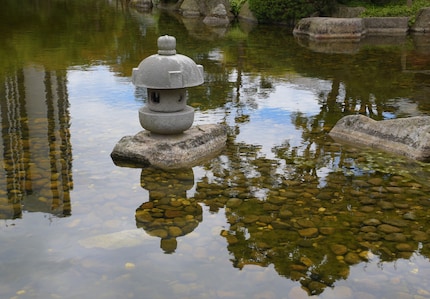
Sabine Rusch points to the ground. In a Chinese garden, it would be covered in mosaics, but here it is made of plain stones. The bridge we cross is also made of granite stone instead of colourfully decorated wood. Again and again we come across small open lawns. «In Japanese, Ma» stands for deliberately designed emptiness. «Kanso» means to reduce to the essentials.
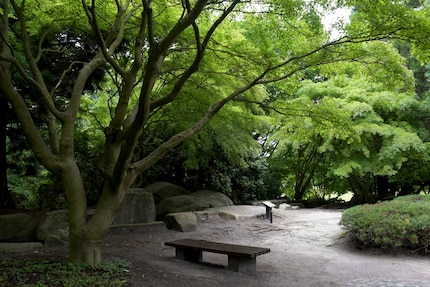
While I'm lost in thought about the meanings, I don't even realise that we've reached the summit of Fuji. Here, landscape architect Yoshikuni Araki has created a unique stream course for Japanese gardens: On one side, water flows into the «Pacific Ocean», on the other side into the «Sea of Japan». «His attention to detail is remarkable», says Sabine Rusch.
On the way back, we pass a camellia bush. It may not have any flowers, but Sabine Rusch's eyes widen: it is her absolute favourite plant. The horticultural engineer has already travelled to China to visit the oldest 600-year-old camellia in the world. And she is writing a book about the history of camellias in northern Germany. No wonder, given that the German media call her «Lady of the Camellias», like the novel by Alexandre Dumas.
Because she adores the plant so much, Sabine Rusch has already had camellias planted all over Hamburg. «On the roadside, in discounts, everywhere. Camellias are hardy and now part of the city», she says with a mischievous grin. As I look one last time at the skyscrapers above the black pines, I suddenly recognise similarities that I hadn't noticed before. I think again of «Shakkei», the borrowed landscape, and I have the feeling that the city and the garden have come together to form a harmonious whole. It's like the Japanese say: my view has widened.
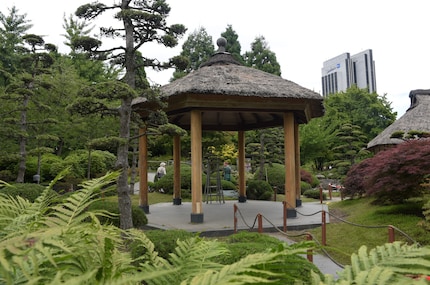
I love anything with four legs or roots - especially my shelter cats Jasper and Joy and my collection of succulents. My favourite things to do are stalking around with police dogs and cat coiffeurs on reportages or letting sensitive stories flourish in garden brockis and Japanese gardens.
Interesting facts about products, behind-the-scenes looks at manufacturers and deep-dives on interesting people.
Show all